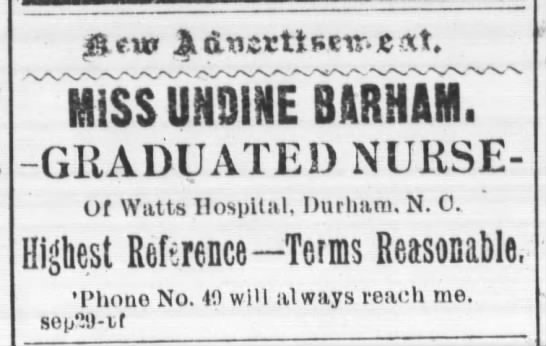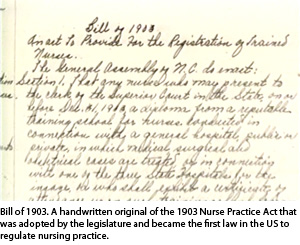1900
Lydia Holman, a nurse from Philadelphia, arrived in Mitchell County in the North Carolina mountains to care for a wealthywoman who was ill with typhoid fever at her vacation home. Holman created a “nurses settlement” in Mitchell County which provided care for citizens in rural, Appalachian Northwest North Carolina for over 60 years.
Learn More: Raleigh Trained Nurses' Association established in 1900
Excerpt from an article in the Raleigh News & Observer on Tuesday, November 27, 1900:
Trained Nurses’ Association
The trained nurses of Raleigh have formed an association for their mutual advantage and protection. Following are the names of officers:
Miss Mary L Wyche, president.
Miss Bessie Mordecai, vice president.
Miss Rosa Hill, recording secretary.
Miss Mary Pitman, treasurer.
They will at an early date open a reading room and library where any member can go and spend her leisure moments. They will have the latest works pertaining to their profession. They will keep an official registry at McGee’s pharmacy, showing when and where any of the members may be found.
Parties out of the city wishing the services of a nurse can communicate with McGee’s pharmacy, or Nurses’ registry.
1901
Twin City Hospital and School of Nursing opened in Winston-Salem.
Dr. Henry F. Long’s Hospital School of Nursing opened in Statesville.
Almost all nurses worked in private duty. Here is a clipping of a newspaper advertisement from 1901:

1901, Sep 28. Miss Undine Barham, Graduate Nurse, Of Watts Hospital, Durham, N.C. The Durham Sun, p.1. Durham, North Carolina.
1902
Fourteen nurses, called together by Mary L. Wyche formed the Raleigh Nurses Association, a forerunner of the North Carolina Nurses Association and the North Carolina Board of Nursing. Membership was restricted to white female nurses.
Good Samaritan Hospital and School of Nursing opened in Charlotte (the second nursing school for African American women to open in the state).
The Wilson Sanatorium with a school of Nursing opened in Wilson, NC.
Dix Hospital in Raleigh opened a nursing school with an emphasis on psychiatric and mental health nursing. Dix Hospital School of Nursing initially admitted both men and women of the white race. The men's program was shortly discontinued.
Newspaper Clippings from 1902
- 1902, Sep 02. State Nurse's Association [meeting]. The Robesonian, p.3. Lumberton, North Carolina.
- 1902, Dec 06. State Nurses Association [charter]. The Wilmington Messenger, p.1. Wilmington, North Carolina.
- 1902, Dec 06. Nurse's Association Chartered, Headquarters in Raleigh--The Purpose Defined. The Morning Post, p.5. Raleigh, North Carolina.
1903
On March 3rd, the North Carolina Nurse Practice Act was enacted, making North Carolina the first state to ensure standards of education and clinical expertise before a person could use the title “Registered Nurse”. The Nurse Practice Act has been modified many times throughout its first century, generally becoming more "nurse friendly" with each change.

On June 4th, Josephine Burton of Craven County became the first Registered Nurse in North Carolina and therefore the first Registered Nurse in the United States. The next day, Mary Rose Batterham of Asheville, long thought to be the first Registered Nurse in the United States, registered in Buncombe County. Charlotte Rhone a Freedman's Hospital graduate from New Bern registered in June 1903 and around the same time Annie Lowe Rutherford of Fayetteville also Registered and they became the first African American Registered Nurses in NC. Mary Briscoe, a St. Agnes Hospital, Raleigh, graduate became the first African American to pass the State Boards in 1916.
Lincoln Hospital and School of Nursing opened in Durham (the 3rd nursng school for African American women to open in NC).
James Walker Hospital School of Nursing in opened in Wilmington.
Learn More: Nursing Practice Act
- North Carolina Nursing Practice Act
- North Carolina bill became a law March 2, 1903. (1907). American Journal of Nursing, 7(4), p. 274.
- Pollitt, P. & Miller, W. (2010). North Carolina: Pioneer in American nursing. American Journal of Nursing, 110(2).
- Shannon, M.L. (1975). Nurses in American history: Our first four licensure laws. American Journal of Nursing, 75(8), pp. 1327-1329.
- Wyche, M.L. (1938). The history of nursing in NC. UNC Press: Chapel HIll, NC.
Learn More: State Board of Medical Examiners of the Association of Trained Nurses of N.C. Organize in Greensboro
From The Daily Journal of New Bern, NC, January 2, 1904.
State Board of Medical Examiners of the Association of Trained Nurses of N.C. Organize in Greensboro, December 16th, 1903.
In accordance with an act of the Legislature of 1908 as provided in the Nurses Registration act, there has been established a Board of Medical Examiners of Trained Nurses of N.C.
This board consists of five members, two physicians elected for six years by the North Carolina Medical Society, and three Trained Nurses elected by the State Nurses Association.
The members are the following,
Dr R S Primrose, of New Bern, who will conduct the examination on Surgery, Anatomy and Physiology.
Dr J W Long, Greensboro, NC, Gynaecology, practice of medicine obstetrics.
The nurses association elected Mrs M H Lawrence, of Rex Hospital, Raleigh, NC, Miss Constance Pfohl, Winston-Salem, Miss M L Wyche, Watts Hospital, Durham, NC.
All the members of the Board were present at the meeting except Dr Primrose who was unavoidable detained.
The following officers were elected,
President, Mrs M H Lawrence.
Miss Wyche, Secretary and Treasurer.
The first meeting of the Board for conducting examinations will be held in Raleigh, Tuesday and Wednesday of the meeting of the NC State Medical Society preceding the meeting of the State Nurses Association. Due notice of this meeting will be given through the State papers.
No nurse can register after Dec. 31st, 1903, without a license from the State Board of Medical Examiners.
MARY L. WYCHE
Sec'y. and Treas.
Watts Hospital, Durham, N.C.
Source: 1904, Jan 02. State Board of Medical Examiners of the Association of Trained Nurses of N.C. Organize in Greensboro, December 16th, 1903. The Daily Journal, p.4. New Bern, North Carolina.
Newspaper Clippings from 1903
- 1903, Feb 10. Bill for Trained Nurses Torn to Pieces. The News and Observer, p.1. Raleigh, North Carolina.
- 1903, Mar 04. Notice to Nurses of North Carolina. The Durham Sun, p.1. Durham, North Carolina.
- 1903, Mar 05. "The 'Registered Nurses' bill has passed." Fayetteville Weekly Observer, p.3. Fayetteville, North Carolina.
- 1903, Mar 06. "The substitue bill of the Senate committee for the 'registered nurses' bill passed the Senate Friday night and is now awaiting action by the House." Tar Heel, p.6. Elizabeth City, North Carolina.
- 1903, May 19. State Nurses' Association. The Robesonian, p.3. Lumberton, North Carolina.
- 1903, Jun 12. Trained Nurses Convention Meets. The Asheville Weekly Citizen, p.8. Asheville, North Carolina.
- 1903, Nov 28. "Anna L. Rutherford, colored, of this city, has received her diploma as graduated nurse and has been registered under the new law for nurses." The Daily Free Press, p.4. Kinston, North Carolina.
1904
Amanda Lawrison of Wilmington became the first Public Health nurse to practice in North Carolina.
Newspaper Clippings from 1904-1905
- 1904, Jan 01. Board of Examiners of Trained Nurses, Officers Have Been Elected and Constitution and By-laws Will Be Adopted Soon -- The Board. The Morning Post, p.5. Raleigh, North Carolina.
- 1904, Jan 02. State Nurses's Association, New Organization Effected Under Act of Legislature. The Durham Sun, p.4. Durham, North Carolina.
- 1905, Apr 13. State Nurses to Meet Here. The Union Republican, p.6. Winston-Salem, North Carolina.
1906
Mercy Hospital, a Catholic Hospital and School of Nursing opened in Charlotte.
St. Leo’s Hospital, a Catholic Hospital and School of Nurisng opened in Greensboro.
Data reported in the 1906 Report of the US Department of Education for Schools of Nursing in North Carolina.
The U.S. Pure Food and Drug Act of 1906 is the first national law regulating purity of food and medicines sold in the United States.The Act required that certain special drugs, including alcohol, morphine, cannabis, heroin and cocaine be accurately labeled with contents and dosage. These and other such drugs continued to be legally available without prescription as long as they were labeled. Nurses along with physicians, other categories of health care workers and individuals could legally puchase and use these drugs as they saw fit. Anyone could walk into a drug store and purchase cocaine, heroin, morphine or numerous other medicines. Heroin was a common ingredient in children's cough medicines, and cocaine was the namesake and key ingredient of Coca-Cola.
Newspaper Clippings from 1906
- 1906, Jun 01. Board Directors Elected, North Carolina Nurses' Association Again in Session Today. The Charlotte News, p.4. Charlotte, North Carolina.
- 1906, Jun 01. Nurses Convention, Eight Graduates Pass the North Carolina State Board. (n.p.). Charlotte, North Carolina.
- 1906, Jun 02. Nurses Elect Officers. The Charlotte Observer, p.10. Charlotte, North Carolina.
1907
Amendments were made to the NC Nurse Practice Act.
Rutherford Hospital School of Nursing opens at Rutherford General Hospital in Rutherford County.
Newspaper Clippings from 1907-1909
- 1907, May 22. Nurses at Durham Negro Hospital Graduate. Greensboro Daily News, p.3. Greensboro, North Carolina.
- 1909, Aug 19. State Nurses' Association, Annual Meeting Being Held at Wrightsville Beach--Business Session, Reception and Public Meeting. The Wilmington Morning Star, p.5. Wilmington, North Carolina.